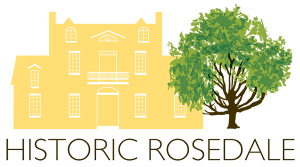
ROSEDALE GROUNDS
GARDENS
A LANDSCAPE DISTINGUISHED BY FIVE GENERATIONS
For much of its history, the Rosedale property was primarily used in a utilitarian manner. Hundreds of acres provided food for those living on the property, and timbering provided income. From the over two hundred years of utilizing the property, there is living evidence from all five generations of families that have resided here: the Frews, Caldwells and Davidsons. They left their mark developing the site as a sustainable property and an environment of beauty and pleasure. From boxwoods planted when the house was completed in 1815, to garlic that still sprouts from one hundred years ago, to the blooming of Mrs. Davidson’s favorite rambling rose, ‘Dorothy Perkins’, planted in the 1950s, the charm of the gardens is enhanced by the five generations that have left their imprints on the landscape.
As one enters the grounds, the diversity of trees, shrubs and plants is wondrous. A vision of large shade trees, exotic shrubs from the orient, and old-fashioned fruit trees hint of the past. Some are Treasure Trees and some have stories which we hope we can share with you.
Strolling through the grounds, the most visually impactful area is the formal gardens. The grandest formations of the gardens began in 1914, when the newly-married Mrs. Louise Heagy Davidson arrived as the lady of the house. She decided to make her mark on the property by creating formal gardens in the colonial revival tradition, as well as bringing the beauty of roses to Rosedale. By the 1950s, Louise had developed three conjoining gardens. All of these gardens were edged in boxwood that Louise rooted from the original two-hundred-year-old boxwood of Archibald Frew. At one point in time 3,000 boxwood adorned the property. Louise’s daughters Mary Louise Davidson and Alice Caldwell Davidson Abel describe how their mother’s energy and determination for the gardens surged after the death of their father, as a way to deal with her grief. Today, Historic Rosedale is continuing the tradition by maintaining and expanding the gardens for the future.
STORIED TREES
One novel tree that is still evident in front of the historic house is a mulberry tree. In 1839, Dr. Caldwell was one of many who participated in the failed “great silkworm experiment”, which gripped the imagination of the nation. It was speculated in the early 19th century that one could make good money by raising silkworms to harvest the cocoons for silk. For $270.00, red mulberry trees were planted, and to his dismay silkworms eat only white mulberry leaves. His great-granddaughter, Alice Davidson Abel, remembered, almost one hundred years later, “I would ride my horse under them and stop to eat” the berries. The experiment failed, but the red mulberry continues to grace Historic Rosedale’s grounds.
Dr. David Caldwell was the most innovative in developing the property. As a scholar, Caldwell subscribed to The Southern Planter, which was an influential agricultural journal published from 1841-1861. The publication explored new farming methods for the southern region. Practices such as crop rotations, deep plowing, the use of cover crops and types of manure were described in the journal. In 1846, it published information on how to thicken an Osage Orange hedge for the practical use as a living fence. Today you can still see the Osage Oranges that were brought back from Florida in 1857 and planted by Dr. Caldwell to divide the barn lots from the back pastures.
TREASURE TREES
Treasure Trees are a select group of champions chosen for their old age, historical significance, great size or as an unusual or rare species in the region of Mecklenburg County, North Carolina. A local arborist began the program in the late 1980s, identifying seventy-four Treasure Trees in the county. Currently, on Historic Rosedale grounds, five of the seven designated Treasure Trees still survive.
CHINESE PARASOL TREE (Firmiana Simplex)
As you enter Historic Rosedale, to the far right of the drive stands the original Chinese Parasol Tree. It was planted in the 1950s from seed by Louise Hagey Davidson. Mary Louise Davidson, Louise’s daughter, remembers her mother gathering the seeds from the Old Burton Smith (Mrs. Lillian) property, which once stood at 700 North Tryon Street. This exotic species is originally from Asia, and grown historically for its wood, which was used for instrumental soundboards. The leaves were also utilized as dried tobacco. Formerly, the species was classified in the Cacao or chocolate family; today it has been assigned to the Malvaceae or hibiscus family.
GREEN ASH (Fraxinus Pennsylvanica)
As the visitor continues up the driveway, to the right side of the historic house stands a grand Green Ash tree. The Ash was a popular shade tree readily used due to its rapid growth of twenty-four inches per year. Rosedale’s Green Ash Treasure Tree has exceeded the average height of 60 feet: when measured, its height was 85 feet. Both George Washington and Thomas Jefferson planted Ash Trees on their properties, some of which still survive. Historically ash wood was used for making oars and canoe paddles, today the wood is widely used in the production of electric guitars.
SASSAFRAS (Sassafras Albidum)
Under the shade of the Green Ash tree stands the surviving sapling of the original Sassafras Treasure Tree. The original tree was struck by lightning sometime after the 1980s, but this devastation has not hinder the original progeny’s growth. The Sassafras is easily identified by its three distinctive leaf patterns on the same plant; unlobed oval, bilobed (mitten shaped) and trilobed (three pronged). All parts of the tree from roots to leaves are edible and have been used medicinally, and for culinary and aromatic purposes. Originally, the main ingredient in root beer, Sassafras was also used in teas to lower high fevers. Prior to the twentieth century, the end of a chewed stick of Sassafras was used to scrub the teeth and to dip snuff.
SWAMP CHESTNUT OAK (Quercus Michauxii)
On the right of the drive, before arriving at the Visitor’s Center, a very grand tree stands. This is the Swamp Chestnut Oak, an unusual species for this location. As the name suggests, this species is known to grow in bottomlands and wetlands where moisture is a mainstay. In 1894, this tree was brought to the site in a sack, as a gift, to Robert Baxter Caldwell, the third generation to live at Rosedale. For many years, this tree was the shade tree for the paddock, which was a fenced area surrounded by barns and livestock quarters. Hogs and cows feasted on the nuts dropped by the tree and horses were allowed to rest there before being placed in their stalls. Historically the wood of such trees was used for basket making, veneer, wheels and fence posts.
OSAGE ORANGE (Maclura Pomifera)
As you look past the Swamp Chestnut Oak, several tall skeletal trunks span the sky. These are old relics of the Osage Orange Trees which caught fire when one of the barns burned in the 1960s. Due to the very dense wood, the trees miraculously sprouted back from the ground, continuing their 160-year-old heritage. In 1857, Robert Baxter Caldwell brought these trees from Florida to plant as a hedgerow, known as a living fence. In the past, Native Americans were known to use Osage Orange wood for bows.
ORIENTAL ARBORVITAE (Platycladus Orientalis, formally Thuja Orientalis)
The Oriental Arborvitae is located in the formal gardens. Mrs. Louise Heagy Davidson, wife of the owner Craighead Davidson (fourth generation to live in the house), used this beautiful tree as the focal point of her garden design, dividing her “little garden” from the “main garden”. As an Asian evergreen conifer, the Arborvitae is slow growing with the average height 20 to 25 feet and average spread 12 to 15 feet. It is believed that the Rosedale conifer dates back to the 1815 time period of Archibald Frew, the original owner of the house, due to the tree’s 35 foot height and 21 foot spread.




